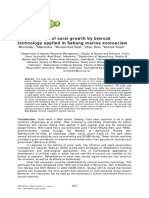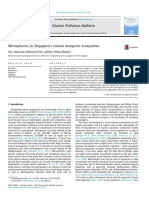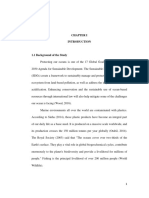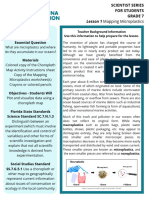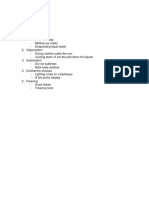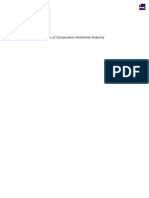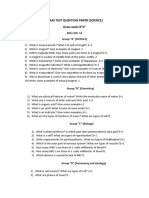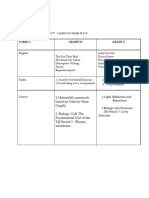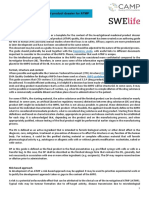0 ratings0% found this document useful (0 votes)
40 viewsA Research Proposal Presented To The Faculty of The Alcate, Victoria, Oriental Mindoro, Philippines
A Research Proposal Presented To The Faculty of The Alcate, Victoria, Oriental Mindoro, Philippines
Uploaded by
Crizhae OconThis research proposal aims to study the propagation of Orange-pipe coral (Tubipora musica) using bamboo and concrete cages as artificial environments. Coral fragments will be attached to bamboo and concrete structures submerged in experimental tanks. Growth, survival, and maximum growth potential of the coral fragments will be measured and compared between the bamboo and concrete environments over 68 days. The results will help determine a better artificial environment for restoring degraded coral reefs.
Copyright:
© All Rights Reserved
Available Formats
Download as DOCX, PDF, TXT or read online from Scribd
A Research Proposal Presented To The Faculty of The Alcate, Victoria, Oriental Mindoro, Philippines
A Research Proposal Presented To The Faculty of The Alcate, Victoria, Oriental Mindoro, Philippines
Uploaded by
Crizhae Ocon0 ratings0% found this document useful (0 votes)
40 views6 pagesThis research proposal aims to study the propagation of Orange-pipe coral (Tubipora musica) using bamboo and concrete cages as artificial environments. Coral fragments will be attached to bamboo and concrete structures submerged in experimental tanks. Growth, survival, and maximum growth potential of the coral fragments will be measured and compared between the bamboo and concrete environments over 68 days. The results will help determine a better artificial environment for restoring degraded coral reefs.
Original Title
prop
Copyright
© © All Rights Reserved
Available Formats
DOCX, PDF, TXT or read online from Scribd
Share this document
Did you find this document useful?
Is this content inappropriate?
This research proposal aims to study the propagation of Orange-pipe coral (Tubipora musica) using bamboo and concrete cages as artificial environments. Coral fragments will be attached to bamboo and concrete structures submerged in experimental tanks. Growth, survival, and maximum growth potential of the coral fragments will be measured and compared between the bamboo and concrete environments over 68 days. The results will help determine a better artificial environment for restoring degraded coral reefs.
Copyright:
© All Rights Reserved
Available Formats
Download as DOCX, PDF, TXT or read online from Scribd
Download as docx, pdf, or txt
0 ratings0% found this document useful (0 votes)
40 views6 pagesA Research Proposal Presented To The Faculty of The Alcate, Victoria, Oriental Mindoro, Philippines
A Research Proposal Presented To The Faculty of The Alcate, Victoria, Oriental Mindoro, Philippines
Uploaded by
Crizhae OconThis research proposal aims to study the propagation of Orange-pipe coral (Tubipora musica) using bamboo and concrete cages as artificial environments. Coral fragments will be attached to bamboo and concrete structures submerged in experimental tanks. Growth, survival, and maximum growth potential of the coral fragments will be measured and compared between the bamboo and concrete environments over 68 days. The results will help determine a better artificial environment for restoring degraded coral reefs.
Copyright:
© All Rights Reserved
Available Formats
Download as DOCX, PDF, TXT or read online from Scribd
Download as docx, pdf, or txt
You are on page 1of 6
Investigation of the Effects of Bamboo and Safe concrete Cages on
Coral Fragment Utilizing Pillars Corals (Dendrogya cylindricus)
as an Artificial Environment for
the Enhancement of Marine Diversity
A Research Proposal
Presented to the Faculty of the
MINDORO STATE COLLEGE OF AGRICULTURE AND TECHNOLOGY
Alcate, Victoria, Oriental Mindoro, Philippines
In Partial Fulfillment
Of the Requirements for the Degree of
BACHELOR OF SCIENCE IN AGRICULTURAL AND BIOSYSTEMS ENGINEERING
By
Mejico, Mia Suzane M.
March 2021
RATIONALE
Several reason such as human activities, bleaching, increase
in cyclone intensity degraded coral reefs worldwide. The
possibility of global warming is named again as a threat for
coral reefs and associated organisms. Global warming can result
in rising sea level and periods of increased temperature stress.
Thus, this may also bring increased storm frequency and
intensity. The threat is through fatal heat stress to corals and
indirectly, by boosting the energy of cyclones that cause coral
destruction and loss of associated organisms. Previous studies
proved such as the potential of bamboo and concrete cage as
artificial coral reef. Furthermore, this study suggests to
recover the indigent conditioned coral reefs in determining the
better artificial environment for coral propagation.
STATEMENT OF THE PROBLEM
The present research aims to study the propagation of
Orange-pipe coral (Tubipora musica) using bamboo and concrete as
an artificial environment. The specific objectives of the present
study are:
1. To identify the most effective artificial environment of the
coral sample utilizing bamboo and concrete cages in terms of:
1.1 Initial growth comparison
1.2 Survival data
1.3 Maximum growth potential
STATEMENT OF THE EXPECTED GOALS AND OUTCOMES
The researcher will be guided by the hypothesis to be
tested.
1. The identification of the most effective artificial
environment of the coral sample between bamboo and concrete cages
in terms of:
1.1 Initial growth
1.2 Survival data
1.3 Maximum growth potential
RESEARCH METHODS
Preparation and Authentication of the coral sample
The coral sample will be requested and then will be
authenticated at UPMSI- Bolinao Marine Laboratory. It will be
brought in the Laboratory of Mindoro State College of Agriculture
and Technology
Set up of Tank in Bamboo Environment
To perform this experiment, a tank will be set up to a place
the micro-fragmented coral in. After visiting an aquarium store
and talking with employees there, who have extensive experience
with setting up tanks and maintaining them, the tank will be
selected to be used will be a 30 1/4 × 12 1/2 × 18 3/4 inches
that contains light, and everything else needed to maintain a
tank, besides a heater incorporated into a tank.
The tank was set up according to the instruction of the
aquarium store, and other reliable sources.
In terms of the presentation of the bamboo, it will be
collected in Gloria, Oriental Mindoro Philippines and will be cut
in 30 × 1/2 inches and will be assembled into the desired design.
One piece of Orange-pipe coral will be cut into smaller pieces.
The fragments will be exploited with a marine super-glue on an
aragonite substrate plug that was much bigger than fragment, in
order for coral fragments to have room to grow. The Aragonite
substrate plug will be put in between of the holes of bamboo. It
will be observed in 68 days.
Set up of Tank in Concrete Experiment
To perform this experiment, a tank will be set up to place
the micro-fragmented coral in. After visiting an aquarium store
and talking with employees there, who have extensive experiment
with setting up tanks and maintaining them, the tank will be
selected to be used will be a 30 1/4 × 12 1/2 × 18 3/4 inches
that contains lights and everything else needed to maintain a
tank, besides a heater incorporated into the tank. The tank was
set-up according to the instruction of the aquarium store and
other reliable sources.
In terms of the preparation of the concrete, it will be
shaped 30 × 1/2 inches and will be assembled to a desired design.
One piece of orange-pipe coral will be cut into smaller pieces.
The fragments will be epoxied with the marine super-glue on an
aragonite substrate plug that was much bigger than fragment, in
order for coral fragment to have room to grow. The Aragonite
substrate plug will be put in between of the holes of the
concrete. It will be observed in 68 days.
Maintenance of the tank
A bi-weekly 25% water change will be performed throughout
the experiment, and the filter will be changed every 2 weeks. The
pump for the filter will be taken out over 2 weeks and cleaned.
The two blue lights (36 watt actinic blue straight pin, and 0.75
watt lunar blue LED bar) were left om from 6 am to 6 pm for 12
hours every day, and the white light used occasionally for
observation.
Finding Exact Measurement of Corals
The exact measurements of coral could not have been found
using calipers, because of the irregular shape of most of the
fragments. In order to find the exact measurements, the photo
imaging app GIMP will be used. The photo of each fragment at each
specific timing will be imported into GIMP.
The area of the circle will then be selected, free-hand,
using the free select tool, and the area of the coral will be
found in pixel using the histogram tool. Then the length of 1 cm
will be found in pixels by measuring 1 cm using measuring tool.
There could be some errors with extremely precise measurements,
but it is assumed that if any errors will be made then they will
be repeated error since the same person was taking all of the
measurements, and the result will not be affected, because the
error will be made for analysis of each picture. The total number
of pixels will then be divided by the length of 1 cm in pixels
squared to find the area of each fragment in cm2.
TESTING PROCEDURE
Initial Growth Comparison
Omission of photographs of larger fragments taken on day 0
made them unusable for data collection. Therefore, to determine
whether there were initial growth differences between the two
artificial environment, only data collected between day 34 and
day 68 will be used. Kruskal-Wallis tests, with fragment type
(micro fragment array vs. larger fragment) as the independent
variable, were used to determine differences in the overall
change in surface area (i.e., amount of tissue created or lost).
The change in the surface area between day 34 and day 68 will be
divided by the initial surface area measured for each array or
larger fragment. Analyses at the bamboo environment and the
Concrete environment and the concrete environment will be
conducted independently to determine if results were consistent
between the two artificial environments. A Kruskal-Wallis test
will also used to determine whether the change in surface area,
standardized by the initial perimeter (i.e., the surface area to
perimeter ratio) significantly differed between the artificial
environments.
Survival Data
Survival analysis, using a cox proportional hazard model
( Therneau, 2015) will be conducted on the survival rate data to
determine whether fragment type influenced overall survival.
Because an array will be considered the primary sampling unit,
rather than each individual micro fragment, arrays will be
considered still alive as long as one micro fragment contained
living tissue. A logistic regression will be used to determine
whether the amount of predation on each fragment effected the
overall survival of each individual micro fragment.
Maximum Growth Potential
Finally, a student’s t-test will be used to determine
whether there were differences between the maximum growth
potential of tubipora musica arrays for bamboo and concrete the
artificial environments that did not experience heavy predation
effects (i.e., <40% loss; see below). Again, the data will be
standardized by the initial surface area of each fragment or
array, and then by total initial perimeter to determine if there
was a difference in the amount of tissue produced by fragment
type per initial cm of perimeter. All statistical analyses will
conducted using the program R( R Core Team, 2017).
BIBLIOGRAPHY
Fadli, N. (2009). Growth rate of Acropora Formosa Fragments
that transplanted on artificial Subtrate Made from Coral
Rubble.BIODIVERSITAS, 10(4), 181-186.
dio:10.13057/biodiv/d100404
Fei, B., Gao, Z., Wang, J., & Liu Z. (2016). Biology Xylem
Secondary. International Center for Bamboo and Rattan, Beijing,
China: Academic Press.
Kinne, O. (1964) The Effects of Temperature and Salinity on
marine and brackfish water animals. Oceanography and Marine
Biology, 2, 281-339
Smyth,K., & Ellliot, M. (2016). Effects of Changing salinity
on the ecology of the marine environment. Stressor in the Marine
Environment, 161-173
Thongtham, N., & Worachananant S. (2013). Survival Rate of
coral fragments transplanted by different methods. Galaxea
Journal of Coral Reef Studies, 351-358
You might also like
- Purpcom 2Document52 pagesPurpcom 2Crizhae OconNo ratings yet
- Utilization of Pulverized Dead Staghorn CORALS (Acropora Muricata) AS CEMENT ReplacementDocument26 pagesUtilization of Pulverized Dead Staghorn CORALS (Acropora Muricata) AS CEMENT ReplacementPearl Angelique CausingNo ratings yet
- Engproc 61 00030Document5 pagesEngproc 61 00030precious.aguilarNo ratings yet
- Coconut Shell Reinforced Cement BricksDocument27 pagesCoconut Shell Reinforced Cement BricksRYANboo989No ratings yet
- Fabrication of Reinforced Bio-Fiberglass Using Selected Agricultural WastesDocument12 pagesFabrication of Reinforced Bio-Fiberglass Using Selected Agricultural WastesAira Joy AnyayahanNo ratings yet
- 188 195Document9 pages188 195Fajar Ihwani SidiqNo ratings yet
- The Escalation of Coral Growth by Biorock Technology Applied in Sabang Marine EcotourismDocument15 pagesThe Escalation of Coral Growth by Biorock Technology Applied in Sabang Marine EcotourismMahendra mahendraNo ratings yet
- Innovative Uses of Recycle Waste Materials As An Artificial Concrete Reef For Estuarine EcosystemDocument7 pagesInnovative Uses of Recycle Waste Materials As An Artificial Concrete Reef For Estuarine EcosystemRameg EtakNo ratings yet
- Microplastics Monitoring in Marine Environment IndonesiaDocument6 pagesMicroplastics Monitoring in Marine Environment IndonesianoviNo ratings yet
- Properties and Behavior of Banana Fiber and Coconut Coir (Baconet) GeotextileDocument13 pagesProperties and Behavior of Banana Fiber and Coconut Coir (Baconet) GeotextileCecille MarcosNo ratings yet
- Crystallinity Cellulose FormulaDocument7 pagesCrystallinity Cellulose Formulaetnomuz2003No ratings yet
- Evaluation of Coconut (Cocos Nucifera) Husk Fibre As A Potential Reinforcing Material For Bioplastic ProductionDocument6 pagesEvaluation of Coconut (Cocos Nucifera) Husk Fibre As A Potential Reinforcing Material For Bioplastic ProductionRaven RainNo ratings yet
- IJMRAP RevisiDocument7 pagesIJMRAP RevisiォォォNo ratings yet
- Acropora Formosa: Frischa A. Sinipirang, Edwin L.A. Ngangi, Joppy D. MudengDocument6 pagesAcropora Formosa: Frischa A. Sinipirang, Edwin L.A. Ngangi, Joppy D. MudengFadly AlqadriNo ratings yet
- v2 Arduino Based Aquarobo Marine Garbage Collector 103556Document19 pagesv2 Arduino Based Aquarobo Marine Garbage Collector 103556John Daryl SedilloNo ratings yet
- Application of Microbead Biological FiltersDocument12 pagesApplication of Microbead Biological FiltersRS Kartika Pulo MasNo ratings yet
- The Potential of Oyster (And: Ostreidae)Document9 pagesThe Potential of Oyster (And: Ostreidae)trexyrimpozNo ratings yet
- Studi Pengaruh Jenis Kemasan Dan Ketebalan Plastik Terhadap KARAKTERISTIK MUTU REBUNG BAMBU TABAH (Gigantochloa Nigrociliata KURZ) KeringDocument10 pagesStudi Pengaruh Jenis Kemasan Dan Ketebalan Plastik Terhadap KARAKTERISTIK MUTU REBUNG BAMBU TABAH (Gigantochloa Nigrociliata KURZ) KeringlulalalaNo ratings yet
- Write Your Data Here: Research 1 (Foreign) : The Release Process of Microfibers: From Surgical FaceDocument11 pagesWrite Your Data Here: Research 1 (Foreign) : The Release Process of Microfibers: From Surgical FaceAnna OfondaNo ratings yet
- Influence of Sampling Sufficiency On Biodiversity Analysis of Microperiphyton Communities For Marine BioassessmentDocument11 pagesInfluence of Sampling Sufficiency On Biodiversity Analysis of Microperiphyton Communities For Marine BioassessmentRiana SijabatNo ratings yet
- Coconut Shell ThesisDocument5 pagesCoconut Shell Thesisbsqw6cbt100% (1)
- Final PaperDocument79 pagesFinal Paperaronguarin234No ratings yet
- JGJHGHJDocument17 pagesJGJHGHJsab lightningNo ratings yet
- Marine Pollution Bulletin: Nur Hazimah Mohamed Nor, Jeffrey Philip ObbardDocument6 pagesMarine Pollution Bulletin: Nur Hazimah Mohamed Nor, Jeffrey Philip ObbardAwinda NurNo ratings yet
- Effectiveness of Seaweed (Chondrus Crispus) As Alternative FiberglassDocument10 pagesEffectiveness of Seaweed (Chondrus Crispus) As Alternative FiberglassRhian PanaganeNo ratings yet
- A Novel Method For Preparing Microplastic Fibers: Matthew ColeDocument7 pagesA Novel Method For Preparing Microplastic Fibers: Matthew Coleraja qammarNo ratings yet
- Microplastics in Sediments: A Review of Techniques, Occurrence and EffectsDocument36 pagesMicroplastics in Sediments: A Review of Techniques, Occurrence and EffectsLeonny MustikaNo ratings yet
- Tugas Kelompok Bahasa Inggris ProfesiDocument4 pagesTugas Kelompok Bahasa Inggris Profesinaja janaNo ratings yet
- Physical Characterization of Starch-Cotton Fiber Composite SheetsDocument6 pagesPhysical Characterization of Starch-Cotton Fiber Composite SheetsIJAR JOURNALNo ratings yet
- The Potential For A Plastic Recycling Facility To Release MicroplasticDocument10 pagesThe Potential For A Plastic Recycling Facility To Release MicroplasticRafaNo ratings yet
- Chapter 3Document6 pagesChapter 3Katsuki HashimotoNo ratings yet
- Research Article: Effects On Mechanical Properties of Recycled PET in Cement-Based CompositesDocument8 pagesResearch Article: Effects On Mechanical Properties of Recycled PET in Cement-Based Compositeswafiyyah fadillahNo ratings yet
- Polythene and Plastics-Degrading Microbes From The Mangrove SoilDocument6 pagesPolythene and Plastics-Degrading Microbes From The Mangrove SoilDaniela FloreaNo ratings yet
- Research ScriptDocument4 pagesResearch ScriptIzuna NobelNo ratings yet
- Article - 2022 - Jve 24 8 22847Document10 pagesArticle - 2022 - Jve 24 8 22847malkinada179No ratings yet
- Group7-Final PaperDocument20 pagesGroup7-Final PaperPollentes, Kim Raven GanancialNo ratings yet
- Sustainable Agri-Power: Utilizing of Plant Spacing in Shared-Anolyte CalamansiDocument11 pagesSustainable Agri-Power: Utilizing of Plant Spacing in Shared-Anolyte CalamansiVinson Josaiah KasilagNo ratings yet
- Bio Digester Manual 1Document9 pagesBio Digester Manual 1Manas deep singhNo ratings yet
- Mi Kro PlastikDocument11 pagesMi Kro PlastikAnonymous eDD0YqzPMNo ratings yet
- Kafabihi 2022 IOP Conf. Ser. Earth Environ. Sci. 967 012047Document11 pagesKafabihi 2022 IOP Conf. Ser. Earth Environ. Sci. 967 012047Handayani LestariNo ratings yet
- Parametric Investigation of Coconut Shells As Partial Replacement of Coarse Aggregates in Sustainable ConcreteDocument7 pagesParametric Investigation of Coconut Shells As Partial Replacement of Coarse Aggregates in Sustainable ConcreteAly OuedryNo ratings yet
- 97-108. Andi Bayu S, Sumoharjo, M. Ma'ruf. Daya Dukung Sistem Akuaponik Untuk Pembesaran Ikan Nila (Oreochromis Niloticus) Skala KomersialDocument12 pages97-108. Andi Bayu S, Sumoharjo, M. Ma'ruf. Daya Dukung Sistem Akuaponik Untuk Pembesaran Ikan Nila (Oreochromis Niloticus) Skala KomersialOzik SyahrezaNo ratings yet
- Properties of Chitosan Films Prepared Under Different Drying ConditionsDocument7 pagesProperties of Chitosan Films Prepared Under Different Drying ConditionsMelidy Eided Hinostroza MitaccNo ratings yet
- Doi 10.15376 - Biores.5.3.1945-1954Document10 pagesDoi 10.15376 - Biores.5.3.1945-1954trang đàmNo ratings yet
- Thesis UneditedDocument99 pagesThesis UneditedRAIYYAN COSAINNo ratings yet
- Eco-Friendly River Bank Protection Technologies Using Coir GeotextilesDocument8 pagesEco-Friendly River Bank Protection Technologies Using Coir GeotextilesThắng PhạmNo ratings yet
- Physical and Mechanical Properties of BananaDocument18 pagesPhysical and Mechanical Properties of BananaReachel TambasacanNo ratings yet
- Lesson 1 Mapping Microplastics: Lesson Time Essential QuestionDocument24 pagesLesson 1 Mapping Microplastics: Lesson Time Essential QuestionErica CameronNo ratings yet
- 2015 - Lee - Distribution and Size Relationships of Plastic Marine Debris On Beaches in South KoreaDocument11 pages2015 - Lee - Distribution and Size Relationships of Plastic Marine Debris On Beaches in South KoreaLim Kok PingNo ratings yet
- TSUKADA Beach Morphodynamics and Its Relationship With The Deposition of Plastic Particles - A Preliminary Study in Southeastern BrazilDocument8 pagesTSUKADA Beach Morphodynamics and Its Relationship With The Deposition of Plastic Particles - A Preliminary Study in Southeastern BrazilAnonymous HijNGQtNNo ratings yet
- Article Zooscan 2004Document8 pagesArticle Zooscan 2004YassineNo ratings yet
- Bioresources Korai Fibres 2010Document17 pagesBioresources Korai Fibres 2010PERUMAL RAVICHANDRANNo ratings yet
- A Study On The Effects of Using Crushed Mussel Shell As An Additive For Concrete Mark Jhun B. Bravo Christoper P. Manlapig Winefredo P. Ylaran JRDocument5 pagesA Study On The Effects of Using Crushed Mussel Shell As An Additive For Concrete Mark Jhun B. Bravo Christoper P. Manlapig Winefredo P. Ylaran JRChristopher ManlapigNo ratings yet
- 88581-61-318313-1-10-20221206 RefDocument12 pages88581-61-318313-1-10-20221206 RefNurun nadhifahNo ratings yet
- Stressed Coral Reef Identification Using Deep LearDocument9 pagesStressed Coral Reef Identification Using Deep LearPijar Hatinurani MerdekaNo ratings yet
- Morphologicalcharacteristicsandotherfeaturesofmangroveclams Geloinaexpansaat Kerteh River Terengganu MalaysiaDocument8 pagesMorphologicalcharacteristicsandotherfeaturesofmangroveclams Geloinaexpansaat Kerteh River Terengganu MalaysiaMarco De GuzmanNo ratings yet
- Science of The Total Environment: ReviewDocument21 pagesScience of The Total Environment: ReviewSamassi sarahNo ratings yet
- Nacaratte Et Al. - 2023 - Early Screening of Suspected Microplastics in Bottled Water in RMDocument8 pagesNacaratte Et Al. - 2023 - Early Screening of Suspected Microplastics in Bottled Water in RMdivmadrazoNo ratings yet
- MAKALAH SEMHAS Afnan FIXDocument9 pagesMAKALAH SEMHAS Afnan FIXMuhammad AfnanNo ratings yet
- Plants From Pitlakes: An inventory of plants from the pitlakes of Eastern Coalfields, IndiaFrom EverandPlants From Pitlakes: An inventory of plants from the pitlakes of Eastern Coalfields, IndiaNo ratings yet
- Monoraphid and Naviculoid Diatoms from the Coastal Laurentian Great LakesFrom EverandMonoraphid and Naviculoid Diatoms from the Coastal Laurentian Great LakesAndrzej WitkowskiNo ratings yet
- 2communication EthicsDocument2 pages2communication EthicsCrizhae OconNo ratings yet
- NSTP Module FinalDocument64 pagesNSTP Module FinalCrizhae Ocon100% (2)
- Pre-Calculus: Module 6-Week 8ADocument1 pagePre-Calculus: Module 6-Week 8ACrizhae OconNo ratings yet
- Propagation CoralDocument24 pagesPropagation CoralCrizhae OconNo ratings yet
- 3ethical CommunicationDocument2 pages3ethical CommunicationCrizhae OconNo ratings yet
- Morley15e PPT Ch13 REVDocument74 pagesMorley15e PPT Ch13 REVCrizhae OconNo ratings yet
- Evaluating Messages and /OR Images of Different Type SOF Texts Reflecting Differen T CulturesDocument15 pagesEvaluating Messages and /OR Images of Different Type SOF Texts Reflecting Differen T CulturesCrizhae OconNo ratings yet
- Feasible RegionDocument3 pagesFeasible RegionCrizhae OconNo ratings yet
- Functions Function Notation Operations On Functions and Types of Functions Functions As Mathematical ModelsDocument19 pagesFunctions Function Notation Operations On Functions and Types of Functions Functions As Mathematical ModelsCrizhae OconNo ratings yet
- Ethics in Communicati ONDocument23 pagesEthics in Communicati ONCrizhae OconNo ratings yet
- Chapter IIIA RegistersDocument25 pagesChapter IIIA RegistersCrizhae OconNo ratings yet
- A Research Paper Presented To The Faculty of The Alcate, Victoria, Oriental Mindoro, PhilippinesDocument13 pagesA Research Paper Presented To The Faculty of The Alcate, Victoria, Oriental Mindoro, PhilippinesCrizhae OconNo ratings yet
- Informative, Persuasive, Entertainment and Special Types of CommunicationDocument11 pagesInformative, Persuasive, Entertainment and Special Types of CommunicationCrizhae OconNo ratings yet
- Ethics 2Document15 pagesEthics 2Crizhae OconNo ratings yet
- College of EngineeringDocument7 pagesCollege of EngineeringCrizhae OconNo ratings yet
- Purposive Communication: at The End of The Unit, The Students Are Expected To Have: Learning OutcomesDocument6 pagesPurposive Communication: at The End of The Unit, The Students Are Expected To Have: Learning OutcomesCrizhae Ocon100% (1)
- Chapter 5Document13 pagesChapter 5Crizhae OconNo ratings yet
- Vinche ChecklistDocument3 pagesVinche ChecklistCrizhae OconNo ratings yet
- Answer To MTP - Intermediate - Syllabus 2012 - Dec2014 - Set 1Document16 pagesAnswer To MTP - Intermediate - Syllabus 2012 - Dec2014 - Set 1Crizhae OconNo ratings yet
- 2D PracticeDocument1 page2D PracticeCrizhae OconNo ratings yet
- Anthropology, Sociology and Political ScienceDocument2 pagesAnthropology, Sociology and Political ScienceCrizhae OconNo ratings yet
- What I Have LearnedDocument1 pageWhat I Have LearnedCrizhae OconNo ratings yet
- Activity - 1 Purposive ComDocument4 pagesActivity - 1 Purposive ComCrizhae OconNo ratings yet
- Quarter 3, Week 5Document3 pagesQuarter 3, Week 5Crizhae OconNo ratings yet
- Quarter 3 Week 4 (Module B)Document1 pageQuarter 3 Week 4 (Module B)Crizhae OconNo ratings yet
- Audit Sampling PlanDocument2 pagesAudit Sampling PlanCrizhae OconNo ratings yet
- Atlas of Comparative Vertebrate Anatomy 1601903010Document71 pagesAtlas of Comparative Vertebrate Anatomy 1601903010Ma. Glaiza MarifosqueNo ratings yet
- KotetuzupaDocument2 pagesKotetuzupaАли АлиевNo ratings yet
- All Rights Reserved - Pranav PundarikDocument7 pagesAll Rights Reserved - Pranav PundarikjohnnyNo ratings yet
- Science DLPDocument5 pagesScience DLPVismay Mona AttarNo ratings yet
- 2023-2024 XII Bio Practical KeyDocument32 pages2023-2024 XII Bio Practical KeyMillind RajparaNo ratings yet
- Down With The HoundDocument17 pagesDown With The HoundAbril RojasNo ratings yet
- Brain and Brands Developing Mutually Informative RDocument17 pagesBrain and Brands Developing Mutually Informative RSourabhNo ratings yet
- Axolotl Paper For Ms Life Science - Gabriel 1Document11 pagesAxolotl Paper For Ms Life Science - Gabriel 1api-205328583100% (1)
- CLASS TEST QUESTION PAPER KiranDocument2 pagesCLASS TEST QUESTION PAPER KiranTHE LYRICISTICNo ratings yet
- CT-1Syllabus of Grade IX & X (2024-2025)Document3 pagesCT-1Syllabus of Grade IX & X (2024-2025)www.juicycokebottleNo ratings yet
- Profat: Moisture, Fat & Protein Meat AnalyzerDocument2 pagesProfat: Moisture, Fat & Protein Meat AnalyzerMelanyNo ratings yet
- Biochemical Engineering Introduction Enzyme KineticsDocument43 pagesBiochemical Engineering Introduction Enzyme KineticsGwen BaralNo ratings yet
- BIOTECHNOLOGYDocument57 pagesBIOTECHNOLOGYBenzDave AgsoyNo ratings yet
- 3rd ObservationDocument44 pages3rd ObservationEnmar Petere-GuevarraNo ratings yet
- EchinocactusDocument12 pagesEchinocactusDavid SilvaNo ratings yet
- March 2016 (v2) QP - Paper 4 CIE Biology A-LevelDocument28 pagesMarch 2016 (v2) QP - Paper 4 CIE Biology A-LevelDivine-joyNo ratings yet
- Chapter 25 OutlineDocument11 pagesChapter 25 OutlineEvelyn KimNo ratings yet
- Nano BioChip Sensors Structure and Functions - SrinivasKasulla - IndiaDocument4 pagesNano BioChip Sensors Structure and Functions - SrinivasKasulla - Indiasrinivas kasullaNo ratings yet
- Eukaryotic Cell Vs Prokaryotic Cell - Difference and Comparison - DiffenDocument9 pagesEukaryotic Cell Vs Prokaryotic Cell - Difference and Comparison - DiffenManendra Patwa100% (1)
- Tissue TransesDocument13 pagesTissue TransesBSMT1A ALMONIA, ERICKA ROSENo ratings yet
- Photosynthesis Homework 2Document4 pagesPhotosynthesis Homework 2dnr3krf8100% (2)
- 16033-Article Text-48226-1-10-20170411Document10 pages16033-Article Text-48226-1-10-20170411Sya'ramdanNo ratings yet
- RHIZOSPHERE Project WorkDocument22 pagesRHIZOSPHERE Project WorkAniekeme GabrielNo ratings yet
- Weller-Stuart Et Al-2017-Molecular Plant PathologyDocument12 pagesWeller-Stuart Et Al-2017-Molecular Plant PathologyJhon ReyesNo ratings yet
- General Psych Summarized Note 2021Document82 pagesGeneral Psych Summarized Note 2021Kal YeshewaNo ratings yet
- Molecular Red ReaderDocument86 pagesMolecular Red ReaderSvebor MidzicNo ratings yet
- Castaways' World - John BrunnerDocument125 pagesCastaways' World - John Brunnershockwaverider3000No ratings yet
- Cell Biology Practice Sheet Day 3 PDFDocument12 pagesCell Biology Practice Sheet Day 3 PDFParul ShahNo ratings yet
- Dossier Guide-for-IMPD ATMP - 1.0Document29 pagesDossier Guide-for-IMPD ATMP - 1.0nsk79inNo ratings yet
- P. 134-149Document16 pagesP. 134-149biblioagroNo ratings yet






